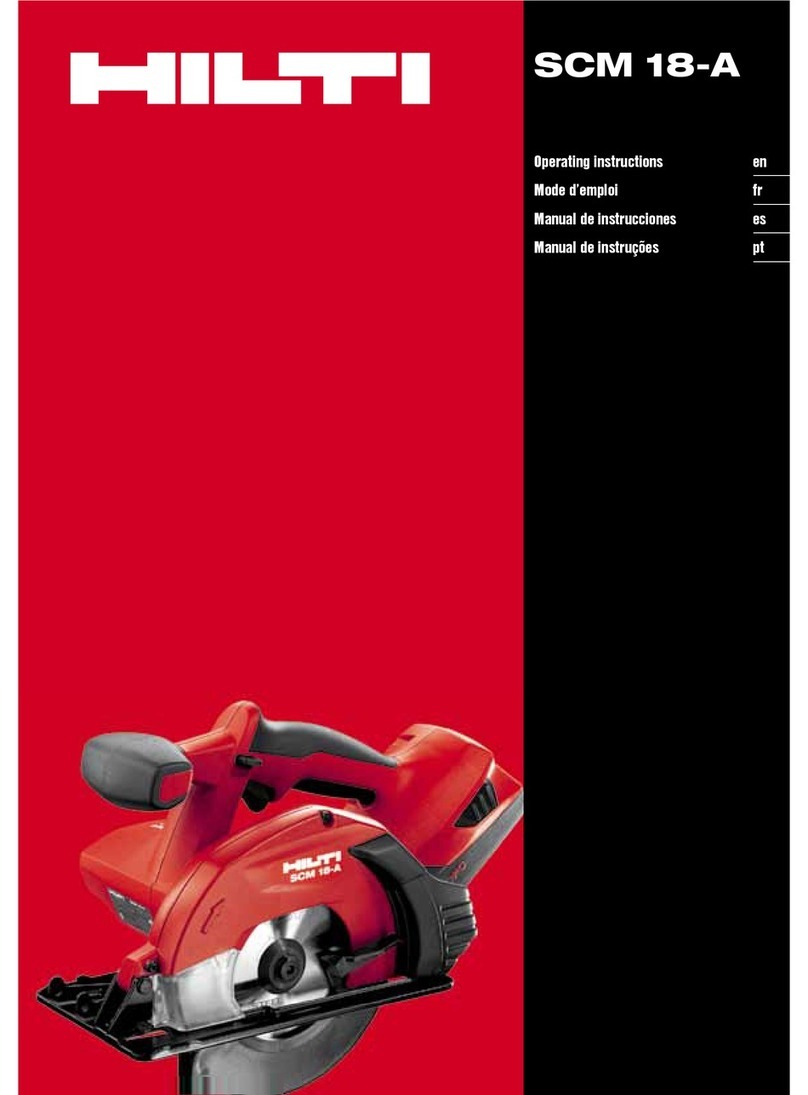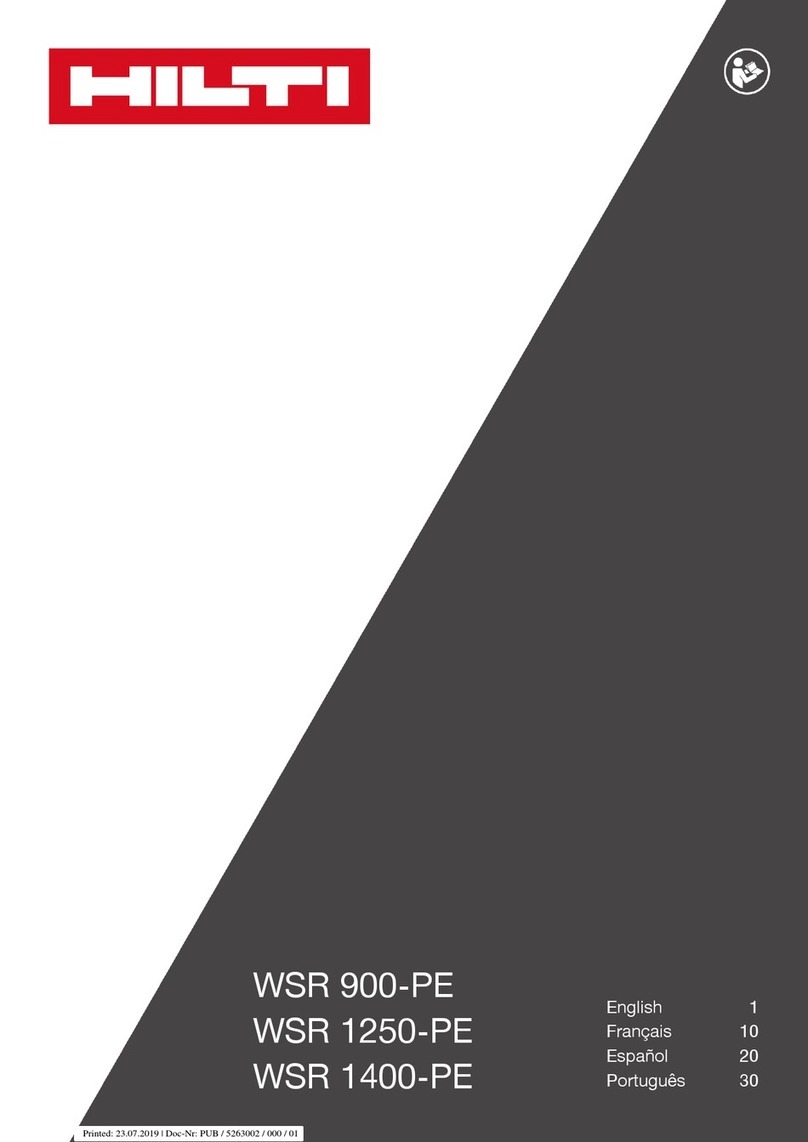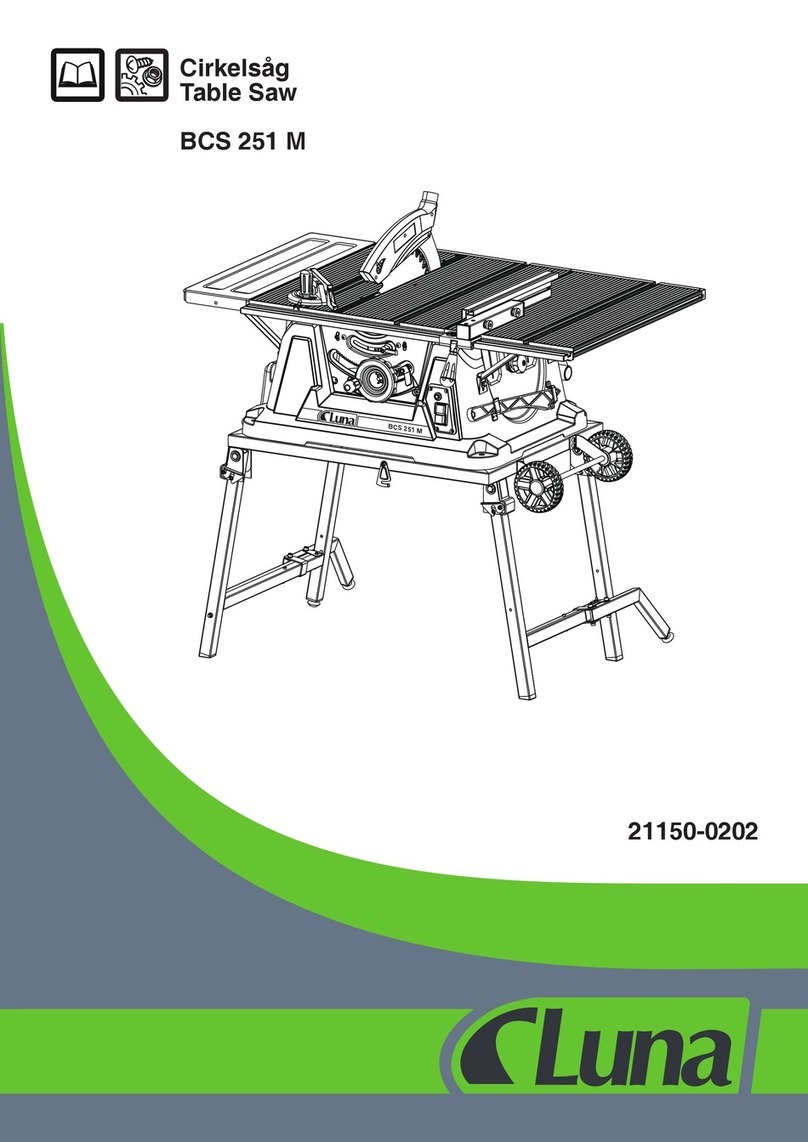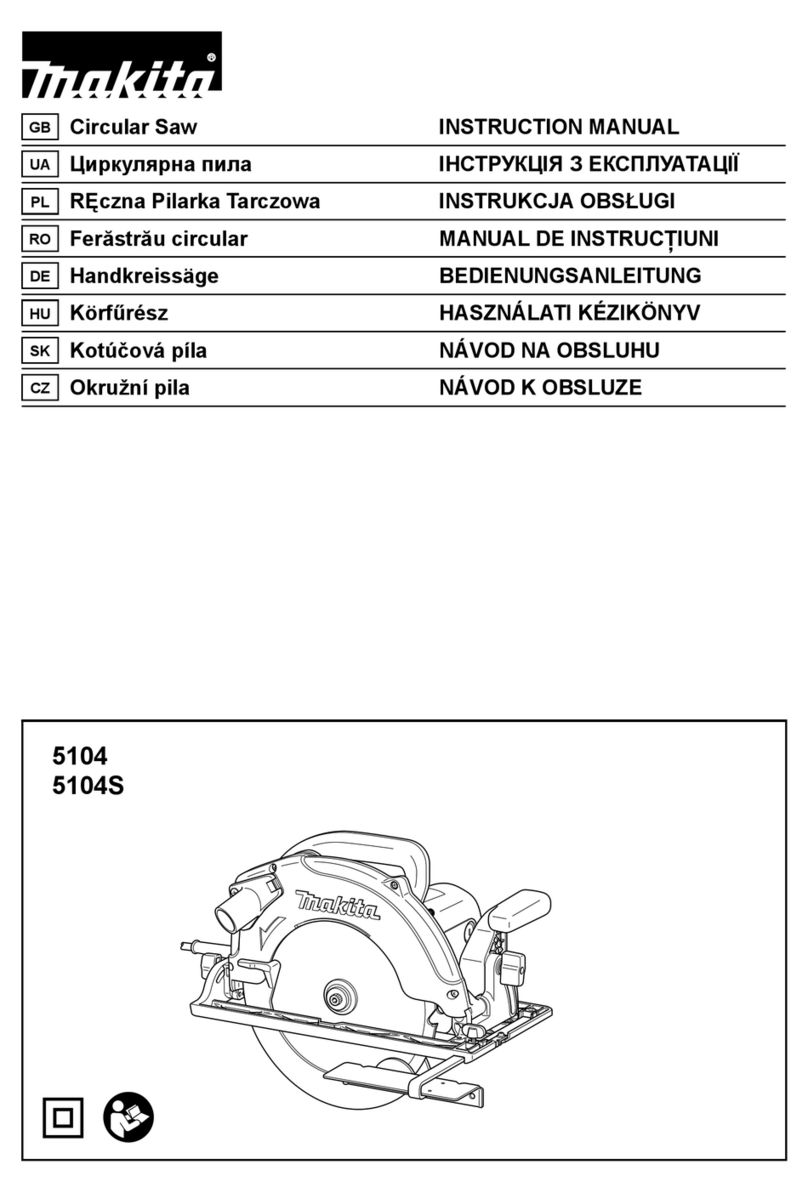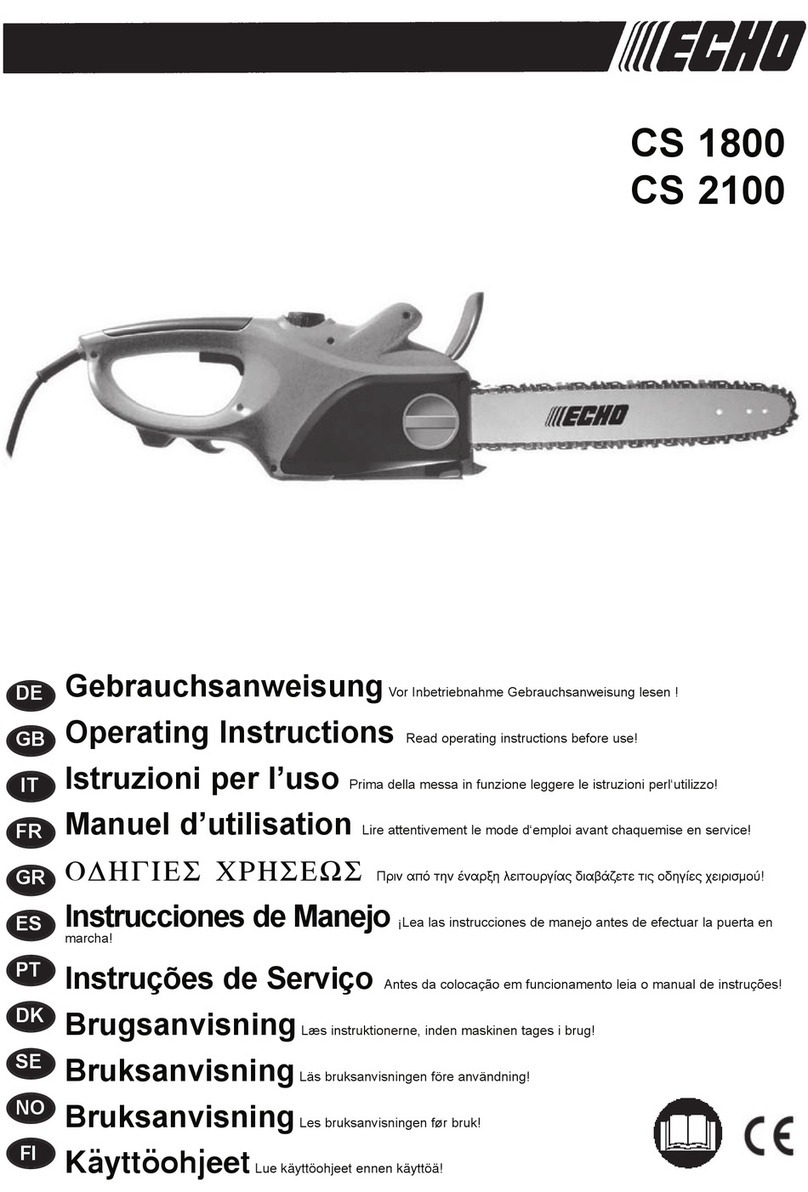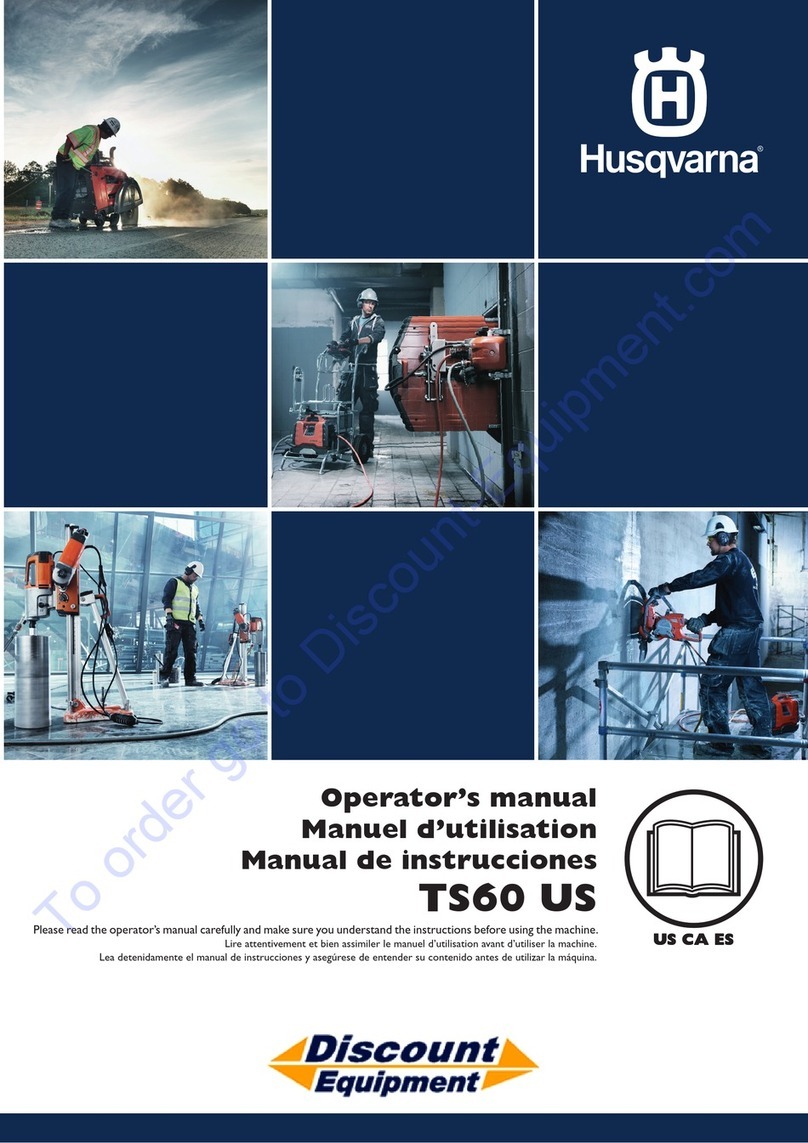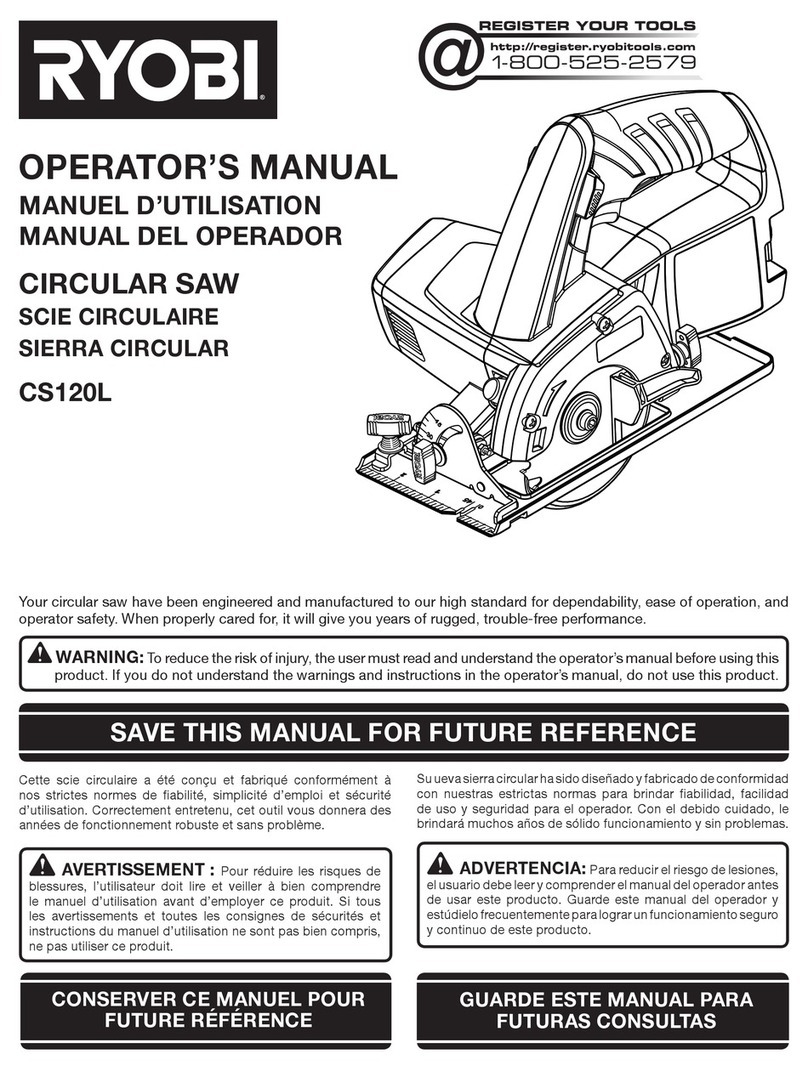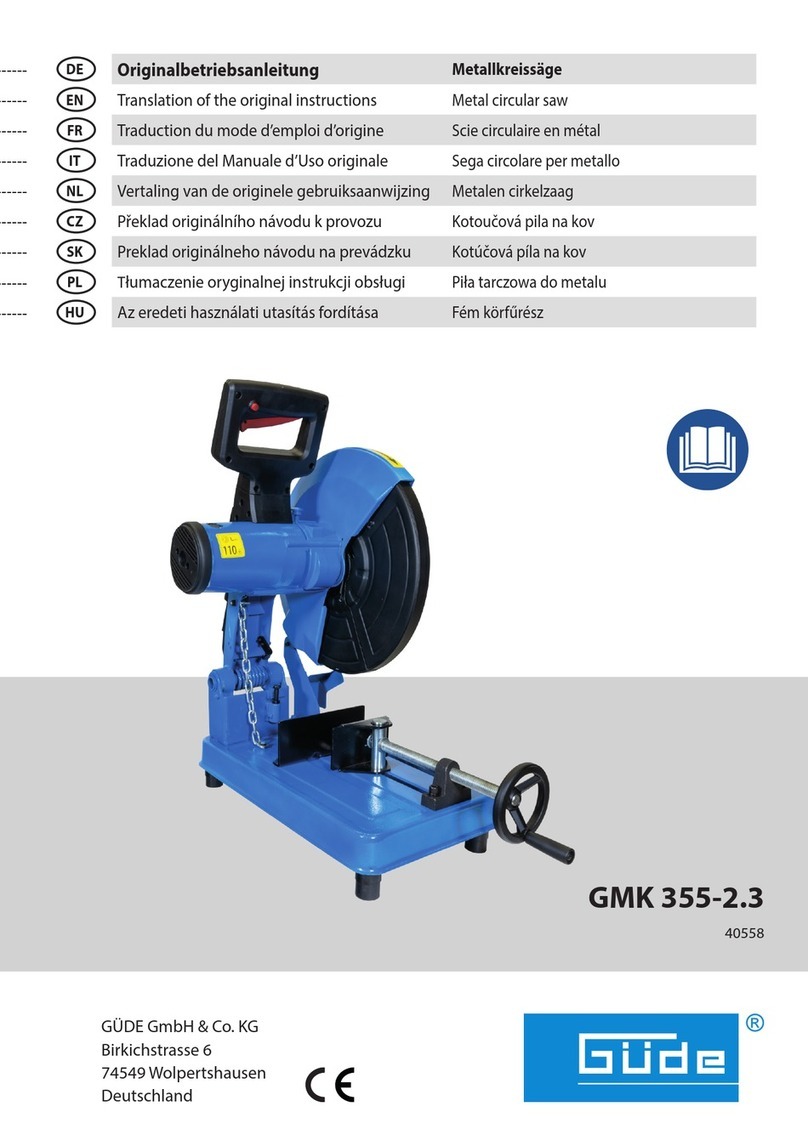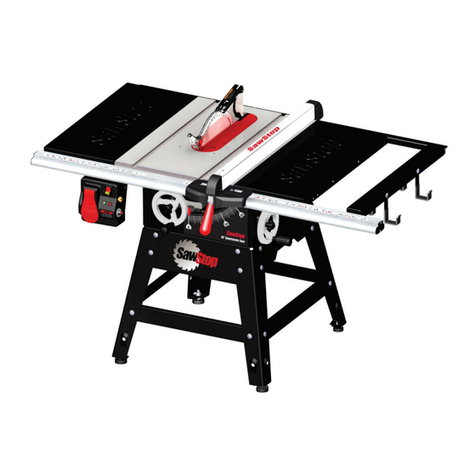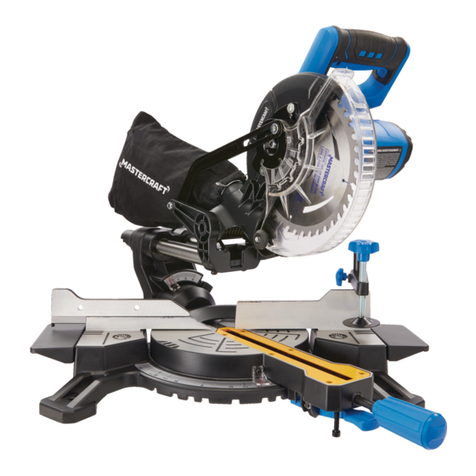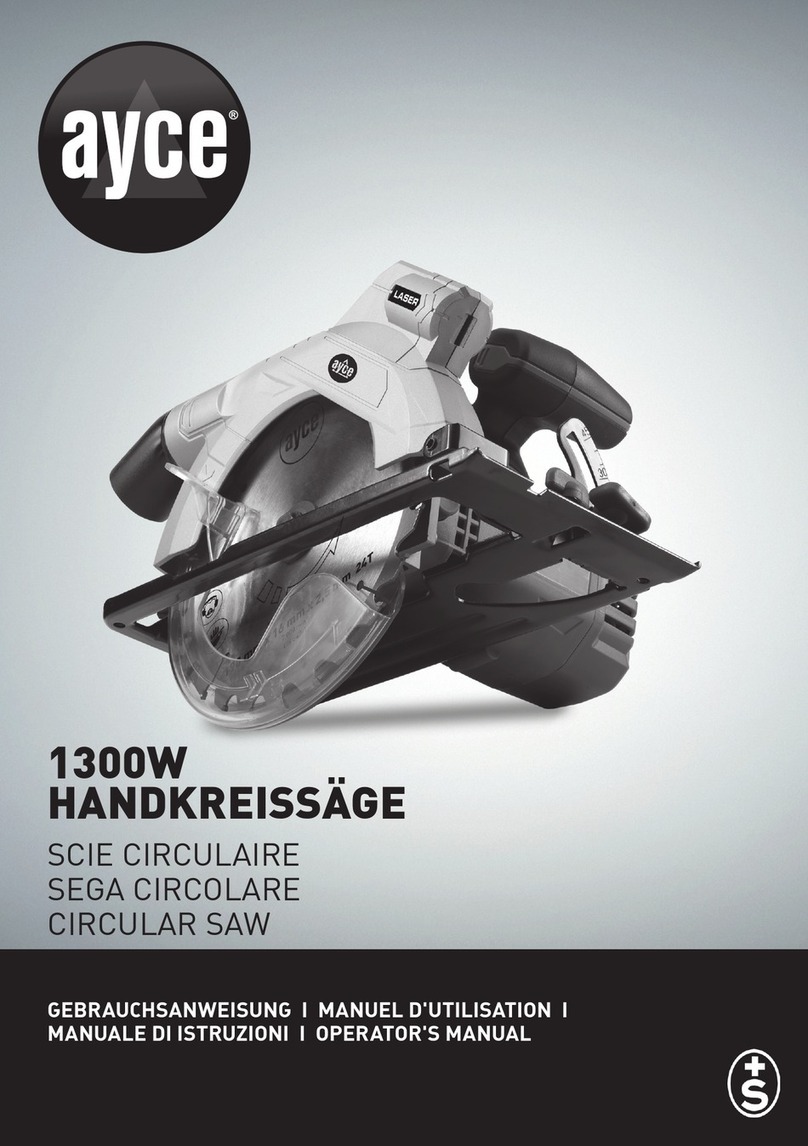Hilti WSC 7.25-S User manual

1
Printed: 11.09.2018 | Doc-Nr: PUB / 5071331 / 000 / 04

2
3
4
5
Printed: 11.09.2018 | Doc-Nr: PUB / 5071331 / 000 / 04

6
7
Printed: 11.09.2018 | Doc-Nr: PUB / 5071331 / 000 / 04

WSC 7.25-S
en Originaloperatinginstructions....................................... 1
fr Noticed'utilisationoriginale ....................................... 10
es Manualdeinstruccionesoriginal .................................... 20
pt Manualdeinstruçõesoriginal ...................................... 30
Printed: 11.09.2018 | Doc-Nr: PUB / 5071331 / 000 / 04

Printed: 11.09.2018 | Doc-Nr: PUB / 5071331 / 000 / 04

*322275* 322275 English 1
1 Information about the documentation
1.1 About this documentation
• Read this documentation before initial operation or use. This is a prerequisite for safe, trouble-free
handling and use of the product.
• Observe the safety instructions and warnings in this documentation and on the product.
• Always keep the operating instructions with the product and make sure that the operating instructions
are with the product when it is given to other persons.
1.2 Explanation of symbols used
1.2.1 Warnings
Warnings alert persons to hazards that occur when handling or using the product. The following signal words
are used:
DANGER
DANGER !
▶Draws attention to imminent danger that will lead to serious personal injury or fatality.
WARNING
WARNING !
▶Draws attention to a potential threat of danger that can lead to serious injury or fatality.
CAUTION
CAUTION !
▶Draws attention to a potentially dangerous situation that could lead to slight personal injury or damage
to the equipment or other property.
1.2.2 Symbols in the documentation
The following symbols are used in this document:
Read the operating instructions before use.
Instructions for use and other useful information
Dealing with recyclable materials
Do not dispose of electric equipment and batteries as household waste
1.2.3 Symbols in the illustrations
The following symbols are used in illustrations:
These numbers refer to the corresponding illustrations found at the beginning of these operating
instructions
The numbering reflects the sequence of operations shown in the illustrations and may deviate
from the steps described in the text
Item reference numbers are used in the overview illustrations and refer to the numbers used in
the product overview section
This symbol is intended to draw special attention to certain points when handling the product.
Wireless data transfer
Printed: 11.09.2018 | Doc-Nr: PUB / 5071331 / 000 / 04

2 English 322275 *322275*
1.3 Product information
Hilti products are designed for professional use and may be operated, serviced and maintained only by
trained, authorized personnel. This personnel must be informed of any particular hazards that may be
encountered. The product and its ancillary equipment can present hazards if used incorrectly by untrained
personnel or if used not in accordance with the intended use.
The type designation and serial number are stated on the rating plate.
▶Write down the serial number in the table below. You will be required to state the product details when
contacting Hilti Service or your local Hilti organization to inquire about the product.
Product information
Circular saw WSC 7.25-S
Generation 02
Serial no.
1.4 Declaration of conformity
We declare, on our sole responsibility, that the product described here complies with the applicable directives
and standards. A copy of the declaration issued by the certification department can be found at the end of
this documentation.
The technical documentation is filed here:
Hilti Entwicklungsgesellschaft mbH | Tool Certification | Hiltistrasse 6 | 86916 Kaufering, Germany
2 Safety
2.1 General power tool safety warnings
WARNING
Read all safety warnings and all instructions. Failure to follow the warnings and instructions may result in
electric shock, fire and/or serious injury.
Save all warnings and instructions for future reference.
Work area safety
▶Keep work area clean and well lit. Cluttered or dark areas invite accidents.
▶Do not operate power tools in explosive atmospheres, such as in the presence of flammable
liquids, gases or dust. Power tools create sparks which may ignite the dust or fumes.
▶Keep children and bystanders away while operating a power tool. Distractions can cause you to lose
control.
Electrical safety
▶Power tool plugs must match the outlet. Never modify the plug in any way. Do not use any adapter
plugs with earthed (grounded) power tools. Unmodified plugs and matching outlets will reduce risk of
electric shock.
▶Avoid body contact with earthed or grounded surfaces, such as pipes, radiators, ranges and
refrigerators. There is an increased risk of electric shock if your body is earthed or grounded.
▶Do not expose power tools to rain or wet conditions. Water entering a power tool will increase the
risk of electric shock.
▶Do not abuse the cord. Never use the cord for carrying, pulling or unplugging the power tool. Keep
cord away from heat, oil, sharp edges or moving parts. Damaged or entangled cords increase the
risk of electric shock.
▶When operating a power tool outdoors, use an extension cord suitable for outdoor use. Use of a
cord suitable for outdoor use reduces the risk of electric shock.
▶If operating a power tool in a damp location is unavoidable, use a residual current device (RCD)
protected supply. Use of an RCD reduces the risk of electric shock.
Personal safety
▶Stay alert, watch what you are doing and use common sense when operating a power tool. Do
not use a power tool while you are tired or under the influence of drugs, alcohol or medication. A
moment of inattention while operating power tools may result in serious personal injury.
▶Use personal protective equipment. Always wear eye protection. Protective equipment such as dust
mask, non-skid safety shoes, hard hat, or hearing protection used for appropriate conditions will reduce
personal injuries.
Printed: 11.09.2018 | Doc-Nr: PUB / 5071331 / 000 / 04

*322275* 322275 English 3
▶Prevent unintentional starting. Ensure the switch is in the off‐position before connecting to power
source, picking up or carrying the tool. Carrying power tools with your finger on the switch or
energising power tools that have the switch on invites accidents.
▶Remove any adjusting key or wrench before turning the power tool on. A wrench or a key left
attached to a rotating part of the power tool may result in personal injury.
▶Do not overreach. Keep proper footing and balance at all times. This enables better control of the
power tool in unexpected situations.
▶Dress properly. Do not wear loose clothing or jewellery. Keep your hair, clothing and gloves away
from moving parts. Loose clothes, jewellery or long hair can be caught in moving parts.
▶If devices are provided for the connection of dust extraction and collection facilities, ensure these
are connected and properly used. Use of dust collection can reduce dust-related hazards.
Power tool use and care
▶Do not force the power tool. Use the correct power tool for your application. The correct power tool
will do the job better and safer at the rate for which it was designed.
▶Do not use the power tool if the switch does not turn it on and off. Any power tool that cannot be
controlled with the switch is dangerous and must be repaired.
▶Disconnect the plug from the power source from the power tool before making any adjustments,
changing accessories, or storing power tools. Such preventive safety measures reduce the risk of
starting the power tool accidentally.
▶Store idle power tools out of the reach of children and do not allow persons unfamiliar with the
power tool or these instructions to operate the power tool. Power tools are dangerous in the hands
of untrained users.
▶Maintain power tools. Check for misalignment or binding of moving parts, breakage of parts and
any other condition that may affect the power tool’s operation. If damaged, have the power tool
repaired before use. Many accidents are caused by poorly maintained power tools.
▶Keep cutting tools sharp and clean. Properly maintained cutting tools with sharp cutting edges are
less likely to bind and are easier to control.
▶Use the power tool, accessories and tool bits etc. in accordance with these instructions, taking
into account the working conditions and the work to be performed. Use of the power tool for
operations different from those intended could result in a hazardous situation.
Service
▶Have your power tool serviced by a qualified repair person using only identical replacement parts.
This will ensure that the safety of the power tool is maintained.
2.2 Safety instructions for all saws
Cutting procedures
▶DANGER: Keep hands away from cutting area and the blade. Keep your second hand on
auxiliary handle, or motor housing. If both hands are holding the saw, they cannot be cut by the blade.
▶Do not reach underneath the workpiece. The guard cannot protect you from the blade below the
workpiece.
▶Adjust the cutting depth to the thickness of the workpiece. Less than a full tooth of the blade teeth
should be visible below the workpiece.
▶Never hold piece being cut in your hands or across your leg. Secure the workpiece to a stable
platform. It is important to support the work properly to minimize body exposure, blade binding, or loss
of control.
▶Hold the power tool by insulated gripping surfaces only, when performing an operation where the
cutting tool may contact hidden wiring or its own cord. Contact with a "live" wire will also make
exposed metal parts of the power tool "live" and could give the operator an electric shock.
▶When ripping, always use a rip fence or straight edge guide. This improves the accuracy of cut and
reduces the chance of blade binding.
▶Always use blades with correct size and shape (diamond versus round) of arbour holes. Blades
that do not match the mounting hardware of the saw will run eccentrically, causing loss of control.
▶Never use damaged or incorrect blade washers or bolt. The blade washers and bolt were specially
designed for your saw, for optimum performance and safety of operation.
Kickback causes and related warnings
• kickback is a sudden reaction to a pinched, bound or misaligned saw blade, causing an uncontrolled
saw to lift up and out of the workpiece toward the operator;
Printed: 11.09.2018 | Doc-Nr: PUB / 5071331 / 000 / 04

4 English 322275 *322275*
• when the blade is pinched or bound tightly by the kerf closing down, the blade stalls and the motor
reaction drives the unit rapidly back toward the operator;
• if the blade becomes twisted or misaligned in the cut, the teeth at the back edge of the blade can dig
into the top surface of the wood causing the blade to climb out of the kerf and jump back toward the
operator.
Kickback is the result of saw misuse and/or incorrect operating procedures or conditions and can be avoided
by taking proper precautions as given below.
▶Maintain a firm grip with both hands on the saw and position your arms to resist kickback forces.
Position your body to either side of the blade, but not in line with the blade. Kickback could cause
the saw to jump backwards, but kickback forces can be controlled by the operator, if proper precautions
are taken.
▶When blade is binding, or when interrupting a cut for any reason, release the trigger and hold the
saw motionless in the material until the blade comes to a complete stop. Never attempt to remove
the saw from the work or pull the saw backward while the blade is in motion or kickback may
occur. Investigate and take corrective actions to eliminate the cause of blade binding.
▶When restarting a saw in the workpiece, centre the saw blade in the kerf and check that saw
teeth are not engaged into the material. If saw blade is binding, it may walk up or kickback from the
workpiece as the saw is restarted.
▶Support large panels to minimise the risk of blade pinching and kickback. Large panels tend to sag
under their own weight. Supports must be placed under the panel on both sides, near the line of cut and
near the edge of the panel.
▶Do not use dull or damaged blades. Unsharpened or improperly set blades produce narrow kerf
causing excessive friction, blade binding and kickback.
▶Blade depth and bevel adjusting locking levers must be tight and secure before making cut. If
blade adjustment shifts while cutting, it may cause binding and kickback.
▶Use extra caution when sawing into existing walls or other blind areas. The protruding blade may
cut objects that can cause kickback.
Lower guard function
▶Check lower guard for proper closing before each use. Do not operate the saw if lower guard does
not move freely and close instantly. Never clamp or tie the lower guard into the open position. If
saw is accidentally dropped, lower guard may be bent. Raise the lower guard with the retracting handle
and make sure it moves freely and does not touch the blade or any other part, in all angles and depths
of cut.
▶Check the operation of the lower guard spring. If the guard and the spring are not operating
properly, they must be serviced before use. Lower guard may operate sluggishly due to damaged
parts, gummy deposits, or a build-up of debris.
▶Lower guard may be retracted manually only for special cuts such as "plunge cuts" and "compound
cuts". Raise lower guard by retracting handle and as soon as blade enters the material, the lower
guard must be released. For all other sawing, the lower guard should operate automatically.
▶Always observe that the lower guard is covering the blade before placing saw down on bench or
floor. An unprotected, coasting blade will cause the saw to walk backwards, cutting whatever is in its
path. Be aware of the time it takes for the blade to stop after switch is released.
2.3 Additional safety instructions for circular saws
▶Bring the saw blade into contact with the workpiece only when the circular saw is switched on.
◁The path of the saw must be free of obstructions above and below the workpiece. Do not saw into
screws, nails or similar objects.
▶Never work overhead with a circular saw.
▶Never attempt to brake the saw blade by applying lateral pressure.
▶Avoid overheating the tips of the saw blade teeth.
▶Always use a saw blade that is suitable for the material you are going to saw.
▶Use only saw blades recommended by Hilti that comply with the EN 847-1 standard.
Printed: 11.09.2018 | Doc-Nr: PUB / 5071331 / 000 / 04

*322275* 322275 English 5
3 Description
3.1 Product overview 1
@On/off switch
;Auxiliary grip
=Spindle lock button
%Hex key
&Cutting angle scale
(Clamping lever for cutting angle adjustment
)Clamping screw for rip fence
+Clamping lever for cutting depth adjustment
§45° cutting line indicator
/0° cutting line indicator
:Rip fence
∙Pivoting guard
$Base plate
£Guard
|Arbor
¡Mounting flange
QClamping flange
WClamping screw
ECutting depth scale
RPivoting guard operating lever
TCutting angle setting
ZLED
3.2 Overview of the guide rail adapter 2
URear retaining lug IFront retaining lug
3.3 Intended use
The product described is a circular saw. It is designed for cutting wood or wood-like materials, plastics,
gypsum plasterboard, gypsum fiberboard and composite materials, up to a cutting depth of 70 mm (2.75 in),
and for miter cuts at angles up to 56°.
3.3.1 Possible misuse
Do not use saw blades not compliant with the technical data and do not use cutting discs, abrasive wheels
or saw blades made of highly alloyed high speed steel (HSS steel). Do not use this power tool to saw metal.
3.4 Items supplied
Circular saw, saw blade, hex key, rip fence, operating instructions.
To help ensure safe and reliable operation, use only genuine Hilti spare parts and consumables. Spare
parts, consumables and accessories approved by Hilti for use with the product can be found at your
local Hilti Store or online at: www.hilti.group
4 Technical data
WSC 7.25S
Weight in accordance with EPTA procedure 01 5.1 kg
Dimensions (L x W x H) 317 x 236 x 269 mm
(12.48 x 9.29 x 10.59 in)
Base plate 290 x 170 mm (11.42 x 6.69 in)
Printed: 11.09.2018 | Doc-Nr: PUB / 5071331 / 000 / 04

6 English 322275 *322275*
WSC 7.25S
Saw blade diameter 184 mm
(7.2 in)
Saw blade disc thickness 1.1 mm … 1.5 mm
(0.04 in … 0.06 in)
Kerf width 1.7 mm … 2.3 mm
(0.07 in … 0.09 in)
Saw blade arbor size 5/8 in
Cutting depth at 0° 0 mm … 62.5 mm
(0 in … 2.46 in)
Cutting depth at 45° 0 mm … 43.5 mm
(0 in … 1.71 in)
Cutting depth at 56° 0 mm … 32.5 mm
(0 in … 1.28 in)
No-load speed 5,800 /min
Protection class II
5 Use of extension cords
WARNING
A damaged supply cord presents a hazard! Do not touch the supply cord or extension cord if damaged
while working. Disconnect the supply cord plug from the power outlet.
▶Check the appliance’s supply cord at regular intervals and have it replaced by a qualified specialist if
found to be damaged.
• Use only extension cords of a type approved for the application and with conductors of adequate
cross-section. Otherwise the performance of the appliance may be affected and the cord may overheat.
• Regularly check the extension cord for damage.
• Replace damaged extension cords.
• When working outdoors, use only extension cords that are approved and correspondingly marked for
this application.
Recommended minimum conductor gauge (cross section) and maximum cable length with 120V
supply voltage
Extension cables AWG 16 AWG 14 AWG 12 AWG 10
Extension cable conductor gauge 1,31 mm² 2,08 mm² 3,31 mm² 5,26 mm²
Extension cable conductor gauge 2,58 kcmil 4,11 kcmil 6,53 kcmil 10,4 kcmil
Extension cable length 25 m 30 m 50 m 100 m
Extension cable length 75 ft 100 ft 150 ft 250 ft
6 Operation
6.1 Removing the saw blade 3
WARNING
Risk of burning injury. A hot accessory tool, clamping flange or clamping screw and the sharp edges of the
saw blade present hazards.
▶Wear protective gloves when changing saw blades.
1. Disconnect the supply cord plug from the power outlet.
2. Press the arbor lockbutton.
3. Turn the saw blade clamping screw with the hex key until the arbor lockbutton engages fully.
4. Use the hex key to slacken the clamping screw by turning it counter-clockwise.
5. Remove the clamping screw from the outer clamping flange.
6. Open the pivoting guard by swinging it clear and remove the saw blade.
Printed: 11.09.2018 | Doc-Nr: PUB / 5071331 / 000 / 04

*322275* 322275 English 7
6.2 Fitting the saw blade
CAUTION
Risk of damage Unsuitable or incorrectly fitted saw blades may damage the saw.
▶Only use blades which are suitable for this saw. Observe the direction-of-rotation arrow on the saw
blade.
1. Disconnect the supply cord plug from the power outlet.
2. Clean the mounting flange and the clamping flange.
3. Fit the mounting flange.
4. Open the pivoting guard.
5. Fit the new saw blade.
6. Fit the outer clamping flange.
7. Secure the clamping flange with the clamping screw by turning it clockwise. At the same time, use one
hand to hold down the arbor lockbutton.
8. Before using the power tool, check that the saw blade is correctly seated and tightened securely.
6.3 Adjusting the cutting depth 4
1. Disconnect the supply cord plug from the power outlet.
2. Rest the circular saw on a flat surface.
3. Release the cutting depth adjustment clamping lever.
4. Lift the circular saw in a scissoring movement and set the cutting depth.
◁The cutting depth is shown on the cutting depth scale.
For a clean-edged cut, set cutting depth to the thickness of the material plus 2 mm.
5. Secure the cutting depth adjustment clamping lever.
6.4 Setting the miter cut angle 5
1. Disconnect the supply cord plug from the power outlet.
2. Release the cutting angle adjustment clamping lever.
3. Pivot the base plate to the desired miter cut angle.
◁The miter cutting angle is shown on the miter cut angle scale.
4. Tighten the cutting angle adjustment clamping lever.
6.5 Selecting a miter cut angle presetting
1. Disconnect the supply cord plug from the power outlet.
2. Release the cutting angle adjustment clamping lever.
3. Pivot the base plate to the 0° position.
4. Set the angle indicator to the desired presetting for the miter cut.
There are three possible presettings: 22.5°, 45° and 56°.
5. Pivot the base plate to the stop.
6. Tighten the cutting angle adjustment clamping lever.
6.6 Cutting line indicator
At the front edge of the base plate of the circular saw is a line indicator for straight cuts and miter cuts (0°
and 45°). This permits accurate cutting at the desired miter angle. The edge of the line indicator corresponds
to the inside of the saw blade. There is a cutting line indicator at the opening for the saw blade at the front
end of the base plate.
Printed: 11.09.2018 | Doc-Nr: PUB / 5071331 / 000 / 04

8 English 322275 *322275*
6.6.1 Sawing along a line
Secure the workpiece to prevent movement.
Position the workpiece so that the saw blade is free to rotate beneath it.
Check that the on/off switch on the product is in the “off” position.
Position the forward section of the circular saw’s base plate on the workpiece but do not bring the
blade into contact with the workpiece.
1. Switch on the circular saw.
2. Guide the circular saw along the cutting line on the workpiece at a suitable speed.
6.7 Sawing with the rip fence
The single-arm rip fence enables precision cuts to be made parallel with a straight edge of the workpiece or
strips of uniform width to be cut. The rip fence can be fitted on either side of the base plate.
6.7.1 Fitting / adjusting the rip fence 6
1. Disconnect the supply cord plug from the power outlet.
2. Slide the rip fence guide under the clamping screw.
3. Set the fence to the correct width for the cut.
4. Tighten the clamping screw.
6.8 Sawing with the guide rail. 7
Sawing with the guide rail can reduce the risk of kickback.
6.8.1 Inserting into / removing from the guide rail adapter
1. Remove the rip fence, if one is fitted.
2. Fit the front edge of the base plate into the front retaining lugs on the guide rail adapter.
3. Swing the rear edge of the base plate down fully into the guide rail adapter. The base plate must engage
fully with the rear retaining lug.
4. To remove, pull the rear retaining lug back slightly and remove the circular saw from the guide rail
adapter.
6.8.2 Longitudinal cuts at 0°
▶Place the circular saw on the guide rail so that the rib fits into the groove in the adapter.
6.8.3 Longitudinal cuts at miter angles up to 56°
▶Guide the circular saw with the outer edge of the guide rail adapter along the rib of the guide rail, as
otherwise the saw blade will contact the guide rail.
6.8.4 Cuts angled across the workpiece
The cutting angle indicated is the angle of deviation from a straight, right-angled cut.
1. Position the guide rail with the zero mark at the edge of the workpiece and then pivot the rail until the
desired angle shown on the angle scale is opposite the zero mark.
2. Secure the guide rail with the two screw clamps.
6.8.5 Sawing offcuts
1. Secure the guide rail from below with two screw clamps.
The saw must be placed on the guide rail behind the workpiece. Make sure that the saw blade is
not in contact with the workpiece.
2. Position the circular saw on the guide rail a short distance from the starting point of the cut.
3. Switch on the circular saw.
4. Push the saw at a steady speed across the workpiece. The pivoting guard opens as it contacts the
actuating edge of the guide rail and closes again at the end of the rail.
Printed: 11.09.2018 | Doc-Nr: PUB / 5071331 / 000 / 04

*322275* 322275 English 9
7 Care and maintenance
7.1 Checks after cleaning and maintenance
After cleaning or maintenance, check that all safety devices are fitted and that they function faultlessly.
▶To check the pivoting guard, open the guard fully by moving the guard operating lever.
◁The pivoting guard must close quickly and completely when the guard operating lever is released.
7.2 Cleaning the guard
1. Remove the saw blade.
2. Clean the parts of the guard carefully with a dry brush.
3. Use a suitable tool to remove deposits or cuttings from the inside surfaces of the parts of the guard.
4. Fit the saw blade. → page 7
8 Disposal
Most of the materials from which Hilti tools and appliances are manufactured can be recycled. The
materials must be correctly separated before they can be recycled. In many countries, your old tools,
machines or appliances can be returned to Hilti for recycling. Ask Hilti Service or your Hilti representative
for further information.
▶Do not dispose of power tools, electronic equipment or batteries as household waste!
9 Manufacturer’s warranty
▶Please contact your local Hilti representative if you have questions about the warranty conditions.
Printed: 11.09.2018 | Doc-Nr: PUB / 5071331 / 000 / 04

10 Français 322275 *322275*
1 Indications relatives à la documentation
1.1 À propos de cette documentation
• Lire intégralement la présente documentation avant la mise en service. C'est la condition préalablement
requise pour assurer la sécurité du travail et un maniement sans perturbations.
• Bien respecter les consignes de sécurité et les avertissements de la présente documentation ainsi que
celles figurant sur le produit.
• Toujours conserver le mode d'emploi à proximité du produit et uniquement le transmettre à des tiers
avec ce mode d'emploi.
1.2 Explication des symboles
1.2.1 Avertissements
Les avertissements attirent l'attention sur des dangers liés à l'utilisation du produit. Les termes de
signalisation suivants sont utilisés :
DANGER
DANGER !
▶Pour un danger imminent qui peut entraîner de graves blessures corporelles ou la mort.
AVERTISSEMENT
AVERTISSEMENT !
▶Pour un danger potentiel qui peut entraîner de graves blessures corporelles ou la mort.
ATTENTION
ATTENTION !
▶Pour attirer l'attention sur une situation pouvant présenter des dangers entraînant des blessures
corporelles légères ou des dégâts matériels.
1.2.2 Symboles dans la documentation
Les symboles suivants sont utilisés dans la présente documentation :
Lire le mode d'emploi avant d'utiliser l'appareil
Pour des conseils d'utilisation et autres informations utiles
Maniement des matériaux recyclables
Ne pas jeter les appareils électriques et les accus dans les ordures ménagères
1.2.3 Symboles dans les illustrations
Les symboles suivants sont utilisés dans les illustrations :
Ces chiffres renvoient à l'illustration correspondante au début du présent mode d'emploi
La numérotation détermine la séquence des étapes de travail dans l'image et peut se différencier
de celles des étapes de travail dans le texte
Les numéros de position sont utilisés dans l'illustration Vue d’ensemble et renvoient aux numé-
ros des légendes dans la section Vue d'ensemble du produit
Ce signe doit inviter à manier le produit en faisant particulièrement attention.
Transmission de données sans fil
Printed: 11.09.2018 | Doc-Nr: PUB / 5071331 / 000 / 04

*322275* 322275 Français 11
1.3 Informations produit
Les produits Hilti sont conçus pour les utilisateurs professionnels et ne doivent être utilisés, entretenus et
réparés que par un personnel agréé et formé à cet effet. Ce personnel doit être au courant des dangers
inhérents à l'utilisation de l'appareil. Le produit et ses accessoires peuvent s'avérer dangereux s'ils sont
utilisés de manière incorrecte par un personnel non qualifié ou de manière non conforme à l'usage prévu.
La désignation du modèle et le numéro de série figurent sur sa plaque signalétique.
▶Inscrivez le numéro de série dans le tableau suivant. Les informations produit vous seront demandées
lorsque vous contactez nos revendeurs ou services après-vente.
Caractéristiques du produit
Scie circulaire WSC 7.25-S
Génération 02
N° de série
1.4 Déclaration de conformité
Nous déclarons sous notre seule et unique responsabilité que le produit décrit ici est conforme aux directives
et normes en vigueur. Une copie de l'attestation délivrée par l'organisme de certification se trouve en fin de
la présente documentation.
Pour obtenir les documentations techniques, s'adresser à :
Hilti Entwicklungsgesellschaft mbH | Zulassung Geräte | Hiltistraße 6 | 86916 Kaufering, DE
2 Sécurité
2.1 Indications générales de sécurité pour les appareils électriques
AVERTISSEMENT Lire et comprendre toutes les consignes de sécurité et instructions. Tout
manquement à l'observation des consignes de sécurité et instructions risque de provoquer une électrocution,
un incendie et/ou de graves blessures.
Les consignes de sécurité et instructions doivent être intégralement conservées pour les utilisations futures.
Sécurité sur le lieu de travail
▶Conserver la zone de travail propre et bien éclairée. Un lieu de travail en désordre ou mal éclairé
augmente le risque d'accidents.
▶Ne pas faire fonctionner les outils électriques en atmosphère explosive et où se trouvent des
liquides, des gaz ou poussières inflammables. Les outils électriques produisent des étincelles qui
peuvent enflammer les poussières ou les fumées.
▶Tenir les enfants et autres personnes à l'écart pendant l'utilisation de l'outil électrique. Si l'appareil
dévie, il y a risque de perte de contrôle de l'appareil.
Sécurité relative au système électrique
▶La fiche de secteur de l'outil électroportatif doit être adaptée à la prise de courant. Ne jamais
modifier la fiche de quelque façon que ce soit. Ne pas utiliser d'adaptateurs avec des outils
électriques à branchement de terre. Des fiches non modifiées et des prises de courant adaptées
réduiront le risque de choc électrique.
▶Éviter le contact physique avec des surfaces mises à la terre tels que tuyaux, radiateurs, cuisinières
et réfrigérateurs. Il y a un risque élevé de choc électrique au cas où votre corps serait relié à la terre.
▶Ne pas exposer les outils électroportatifs à la pluie ou à l'humidité. La pénétration d'eau à l'intérieur
d'un outil électroportatif augmentera le risque d'un choc électrique.
▶Ne jamais utiliser le cordon à d'autres fins que celles prévues, telles que pour porter, accrocher ou
débrancher l'outil électroportatif de la prise de courant. Maintenir le cordon à l'écart de la chaleur,
des parties grasses, des bords tranchants ou des parties de l'appareil en mouvement. Des cordons
endommagés ou emmêlés augmentent le risque de choc électrique.
▶Si l'outil électroportatif est utilisé à l'extérieur, utiliser uniquement une rallonge homologuée pour
les applications extérieures. L'utilisation d'une rallonge électrique homologuée pour les applications
extérieures diminue le risque d'un choc électrique.
▶Si l'utilisation de l'outil électrique dans un environnement humide ne peut pas être évitée, utiliser
un interrupteur de protection contre les courants de court-circuit. L'utilisation d'un tel interrupteur
de protection réduit le risque d'une décharge électrique.
Printed: 11.09.2018 | Doc-Nr: PUB / 5071331 / 000 / 04

12 Français 322275 *322275*
Sécurité des personnes
▶Rester vigilant, surveiller ce que l'on fait. Faire preuve de bon sens en utilisant l'outil électroportatif.
Ne pas utiliser l'outil électroportatif en étant fatigué ou sous l'emprise de l'alcool, de drogues ou
de médicaments. Un moment d'inattention lors de l'utilisation de l'outil électroportatif peut entraîner
des blessures graves.
▶Utiliser un équipement de protection individuelle et toujours porter une protection pour les
yeux. Les équipements de protection individuelle tels que masque antipoussière, chaussures de
sécurité antidérapantes, casque de protection ou protection acoustique suivant l'utilisation de l'outil
électroportatif, réduiront le risque de blessures des personnes.
▶Éviter une mise en service par mégarde. S'assurer que l'outil électrique est arrêté avant de
le brancher à l'alimentation électrique, de le prendre ou de le porter. Le fait de porter l'outil
électroportatif avec le doigt sur l'interrupteur ou de brancher l'appareil sur la source de courant lorsque
l'interrupteur est en position de fonctionnement peut entraîner des accidents.
▶Retirer tout outil de réglage ou toute clé avant de mettre l'outil électroportatif en fonctionnement.
Une clé ou un outil se trouvant sur une partie en rotation peut causer des blessures.
▶Adopter une bonne posture. Veiller à toujours garder une position stable et équilibrée. Cela permet
un meilleur contrôle de l'outil électroportatif dans des situations inattendues.
▶S'habiller de manière adaptée. Ne pas porter de vêtements amples ni de bijoux. Garder les
cheveux, les vêtements et les gants à distance des parties en mouvement. Des vêtements amples,
des bijoux ou des cheveux longs peuvent être happés par des parties en mouvement.
▶Si des dispositifs servant à aspirer ou à recueillir les poussières doivent être utilisés, s'assurer
qu'ils sont effectivement raccordés et correctement utilisés. L'utilisation d'un dispositif d'aspiration
de la poussière peut réduire les risques dus aux poussières.
Utilisation et maniement de l'outil électroportatif
▶Ne pas forcer l'appareil. Utiliser l'outil électroportatif adapté au travail à effectuer. Un outil
électroportatif approprié réalisera mieux le travail et de manière plus sûre au régime pour lequel il a été
conçu.
▶Ne pas utiliser d'outil électroportatif dont l'interrupteur est défectueux. Tout outil électroportatif qui
ne peut plus être mis en ou hors fonctionnement est dangereux et doit être réparé.
▶Retirez la fiche de la prise de courant avant d’effectuer des réglages sur l’appareil, de changer les
accessoires, ou de ranger l’appareil. Cette mesure de précaution empêche une mise en fonctionnement
par mégarde de l'outil électroportatif.
▶Conserver les outils électroportatifs non utilisés hors de portée des enfants. Ne pas permettre
l'utilisation de l'appareil à des personnes qui ne se sont pas familiarisées avec celui-ci ou qui n'ont
pas lu ces instructions. Les outils électroportatifs sont dangereux lorsqu'ils sont entre les mains de
personnes non initiées.
▶Prendre soin des outils électroportatifs. Vérifier que les parties en mouvement fonctionnent
correctement et qu'elles ne sont pas coincées, et contrôler si des parties sont cassées ou
endommagées de sorte que le bon fonctionnement de l'outil électroportatif s'en trouve entravé.
Faire réparer les parties endommagées avant d'utiliser l'appareil. De nombreux accidents sont dus
à des outils électroportatifs mal entretenus.
▶Garder les outils de coupe affûtés et propres. Des outils destinés à couper correctement entretenus
avec des pièces coupantes tranchantes sont moins susceptibles de bloquer et sont plus faciles à
contrôler.
▶L'outil électroportatif, les accessoires, les outils amovibles, etc. doivent être utilisés conformément
à ces instructions. Tenir également compte des conditions de travail et du travail à réaliser.
L'utilisation des outils électroportatifs à d'autres fins que celles prévues peut entraîner des situations
dangereuses.
Service
▶L'outil électroportatif doit uniquement être réparé par un personnel qualifié, utilisant exclusivement
des pièces de rechange d'origine. Ceci permet d'assurer la sécurité de l'outil électroportatif.
2.2 Consignes de sécurité pour toutes les scies
Procédé de sciage
▶DANGER : Bien garder les mains à distance de la zone de sciage et de la lame de scie. Tenir la
poignée supplémentaire ou le carter du moteur de l’autre main. Si la scie est tenue des deux mains,
celles-ci ne risquent pas d'être blessées par la lame de scie.
▶Ne pas passer les mains sous la pièce travaillée. Sous la pièce travaillée, le capot de protection ne
peut pas protéger l'utilisateur contre la lame de scie.
Printed: 11.09.2018 | Doc-Nr: PUB / 5071331 / 000 / 04

*322275* 322275 Français 13
▶Adapter la profondeur de coupe à l'épaisseur de la pièce travaillée. Moins d’une dent complète
devrait apparaître sous la pièce.
▶Ne jamais tenir la pièce à scier avec la main ou sur la jambe. Fixer la pièce sur un support stable.
Il est important de bien fixer la pièce, afin de réduire au minimum les dangers de contact physique, de
coincement de la lame de scie ou de perte de contrôle.
▶Saisir l’outil électroportatif uniquement par les surfaces isolées des poignées lors des travaux
pendant lesquels l'accessoire risque de toucher des câbles électriques cachés ou son propre
câble d'alimentation réseau. Le contact avec un câble sous tension met les parties métalliques de
l'outil électroportatif sous tension et provoque une décharge électrique.
▶Toujours utiliser une butée ou un guidage droit de bords pour des coupes longitudinales. Ceci
améliore la précision de coupe et réduit le danger de voir la lame de scie se coincer.
▶Toujours utiliser des lames de scie de la bonne taille et dont l'alésage de fixation est de forme
appropriée (par ex. en étoile ou rond). Les lames de scie qui ne conviennent pas aux pièces
d'assemblage de la scie sont comme voilées et entraînent une perte de contrôle.
▶Ne jamais utiliser de rondelles ou de vis endommagées ou qui ne conviennent pas pour la lame de
scie. Les rondelles et vis pour la lame de scie ont spécialement été conçues pour cette scie, pour des
performances et une sécurité de fonctionnement optimales.
Contrecoup – Causes et consignes de sécurité correspondantes
• un contrecoup est une réaction soudaine d'une lame de scie restée accrochée, coincée ou mal orientée,
qui provoque le soulèvement incontrôlé de la scie et sa sortie de la pièce travaillée en direction de
l'utilisateur ;
• si la lame de scie reste accrochée ou se coince dans la fente sciée qui se ferme, elle se bloque et la force
du moteur entraîne la scie en direction de l'utilisateur ;
• si la lame de scie est tordue ou mal orientée dans le tracé de la coupe, les dents du bord arrière de la
lame de scie risquent de s'accrocher dans la surface de la pièce, faisant sauter brusquement la lame de
scie de la fente et propulsant la scie vers l’arrière en direction de l'utilisateur.
Un contrecoup est la conséquence d'une utilisation erronée ou inappropriée de la scie. Il peut être évité en
prenant les mesures de précaution adaptées telles que décrites ci-dessous.
▶Bien tenir la scie des deux mains et mettre les bras dans une position permettant d'amortir la
force de contrecoup. Toujours se tenir latéralement à la lame de scie, le corps de l'utilisateur ne
doit jamais être dans l'alignement de la lame de scie. Lors d’un contrecoup, la scie circulaire risque
d’être propulsée vers l’arrière, l'utilisateur peut cependant contrôler les forces de contrecoup en prenant
des mesures de précaution appropriées.
▶Si la lame de scie se coince ou que le travail est interrompu, arrêter la scie et la tenir dans le
matériau sans bouger jusqu'à ce que la lame de scie s'immobilise. Ne jamais essayer de sortir la
scie de la pièce travaillée ou de la tirer vers l'arrière tant que la lame de scie bouge, sans quoi un
contrecoup risque de se produire. Déterminer et résoudre la cause du coincement de la lame de scie.
▶Si une scie qui s’est bloquée dans une pièce doit être remise en marche, centrer la lame de scie
dans la fente et vérifier que les dents de la scie ne sont pas restées accrochées dans la pièce. Si la
lame de scie est coincée, elle peut sortir de la pièce ou causer un contrecoup quand la scie est remise
en marche.
▶Soutenir les grands panneaux travaillés afin de réduire le risque d’un contrecoup causé par une
lame de scie coincée. Les grands panneaux risquent de s’arquer sous leur propre poids. Les panneaux
doivent être soutenus des deux côtés par des supports, près de la fente de scie ainsi que sur l'arête.
▶Ne pas utiliser de lames de scie émoussées ou endommagées. Les lames de scie dont les dents
sont émoussées ou mal orientées entraînent une fente trop étroite et par conséquent une friction élevée,
un coincement de la lame de scie et un contrecoup.
▶Resserrer les réglages de la profondeur de coupe ainsi que de l’angle de coupe avant le sciage. La
lame de scie risque de se coincer et un contrecoup de se produire si les réglages se modifient pendant
l’opération de sciage.
▶Procéder avec une extrême prudence en cas de sciage dans des murs existants ou autres zones
imprévisibles. Lors du sciage, la lame de scie plongeante risque de se coincer dans des objets cachés
et de causer un contrecoup.
Fonction du capot de protection inférieur
▶Contrôler avant chaque utilisation que le capot inférieur de protection ferme parfaitement. Ne
pas utiliser la scie quand le capot inférieur de protection ne peut pas bouger librement et ne se
ferme pas tout de suite. Ne jamais coincer ou attacher le capot inférieur de protection en position
ouverte. Si, par mégarde, la scie tombe par terre, le capot inférieur de protection risque d'être déformé.
Ouvrir le capot de protection à l’aide du levier et s’assurer qu’il peut encore bouger librement et ne
Printed: 11.09.2018 | Doc-Nr: PUB / 5071331 / 000 / 04

14 Français 322275 *322275*
touche ni la lame de scie ni d'autres éléments de l'appareil, et ceci pour tous les angles de coupe ainsi
que pour toutes les profondeurs de coupe.
▶Contrôler le bon fonctionnement du ressort du capot inférieur de protection. Faire effectuer
un entretien de la scie avant son utilisation, si le capot de protection inférieur et le ressort ne
fonctionnent pas parfaitement. Des parties endommagées, des restes de colle ou des accumulations
de copeaux font que le capot inférieur de protection fonctionne plus lentement.
▶N'ouvrir le capot inférieur de protection manuellement que pour des coupes spéciales telles que
les "coupes en plongée et coupes angulaires". Ouvrir le capot inférieur de protection à l’aide du
levier et le lâcher dès que la lame de scie plonge dans la pièce. Pour toutes les autres opérations de
sciage, le capot inférieur de protection doit fonctionner automatiquement.
▶Ne pas déposer la scie sur l’établi ou le sol sans que le capot inférieur de protection couvre la
lame de scie. Une lame de scie non protégée et qui n’est pas encore à l’arrêt total fait bouger la scie
dans le sens contraire au sens de coupe et scie tout ce qui est sur son chemin. Tenir compte du temps
de ralentissement de la scie.
2.3 Consignes de sécurité supplémentaires spécifiques aux scies circulaires
▶Uniquement amener la scie circulaire à l'état mis en marche contre la pièce travaillée.
◁La surface de coupe doit être libre de tout obstacle, en haut et en bas. Ne pas scier des vis, clous ou
objets analogues.
▶Ne jamais travailler avec une scie circulaire au plafond ou au-dessus de la tête.
▶Ne jamais freiner la lame de scie en exerçant une contre-pression latérale.
▶Éviter toute surchauffe des pointes des dents de scie.
▶Toujours utiliser la lame de scie adaptée au matériau support à scier.
▶Utiliser exclusivement des lames de scie recommandées par Hilti, conformes à la norme EN 847-1.
3 Description
3.1 Vue d'ensemble du produit 1
@Interrupteur Marche / Arrêt
;Poignée supplémentaire
=Bouton de blocage de la broche
%Clé pour vis à tête six pans creux
&Échelle d'angle de coupe
(Levier de blocage pour réglage de l'angle de
coupe
)Vis de blocage pour la butée parallèle
+Levier de blocage pour réglage de la profon-
deur de coupe
§Repère de coupe 45°
/Repère de coupe 0°
:Butée parallèle
∙Capot de protection oscillant
$Semelle
£Carter de protection
|Broche d'entraînement
¡Flasque support
QFlasque de serrage
WVis de serrage
EÉchelle de profondeur de coupe
RLevier de commande du capot de protection
oscillant
TPréréglage de l'angle de coupe
ZDEL
Printed: 11.09.2018 | Doc-Nr: PUB / 5071331 / 000 / 04
Other manuals for WSC 7.25-S
2
Table of contents
Languages:
Other Hilti Saw manuals
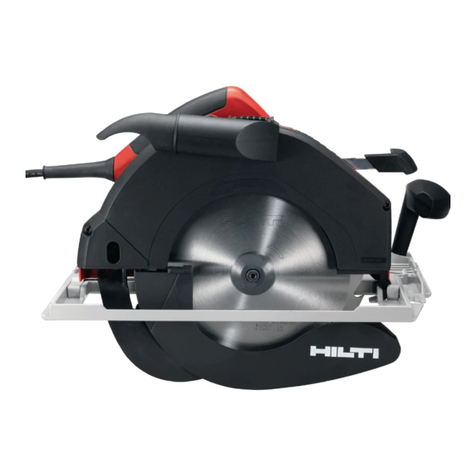
Hilti
Hilti WSC 85 User manual
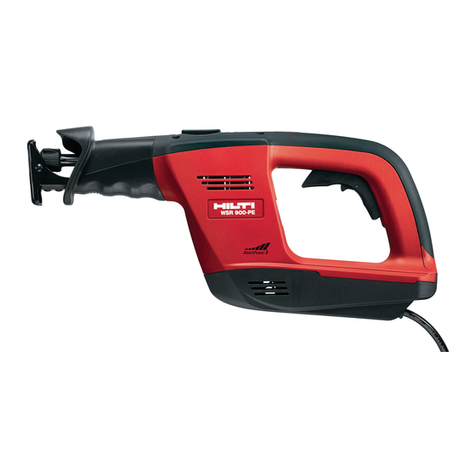
Hilti
Hilti WSR 900-PE User manual
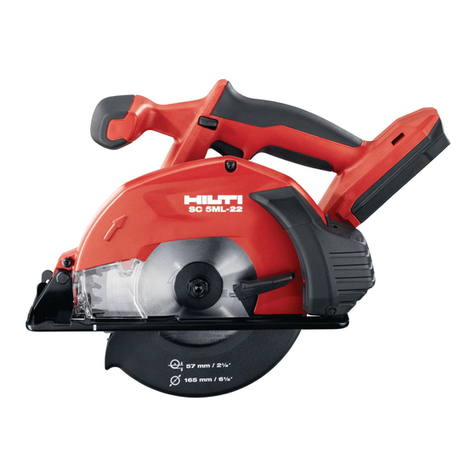
Hilti
Hilti SC 5ML-22 User manual

Hilti
Hilti SR 6-A22 User manual
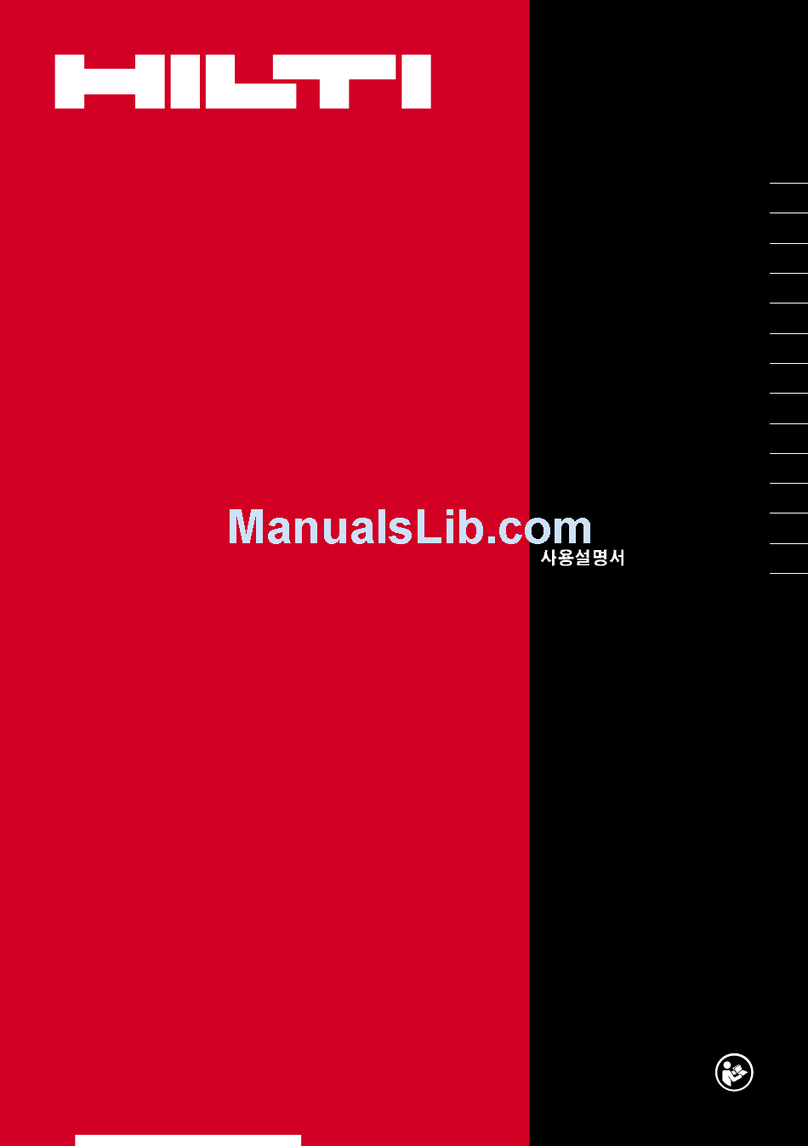
Hilti
Hilti SC 55W User manual
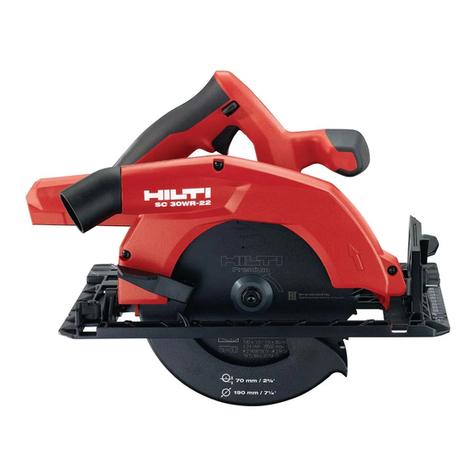
Hilti
Hilti Nuron SC 30WR-22 User manual
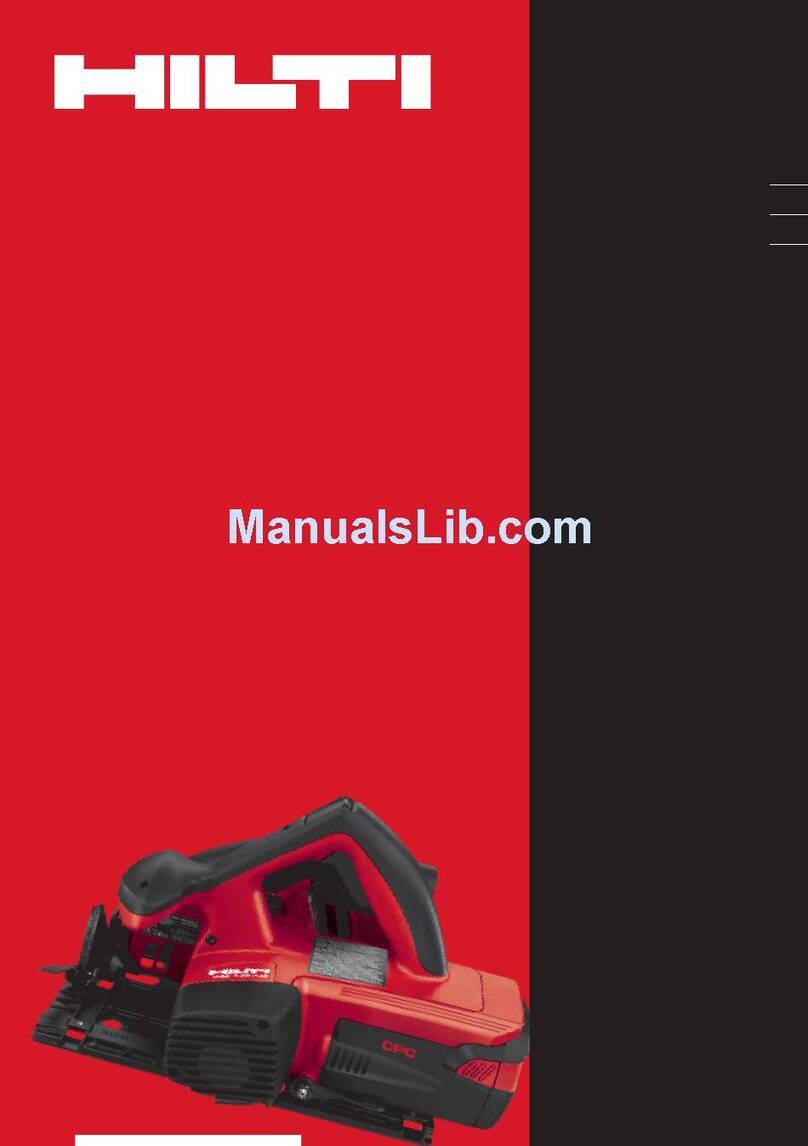
Hilti
Hilti WSC 7.25-A36 User manual

Hilti
Hilti WSC 85 User manual

Hilti
Hilti Nuron SC 6WL-22 User manual
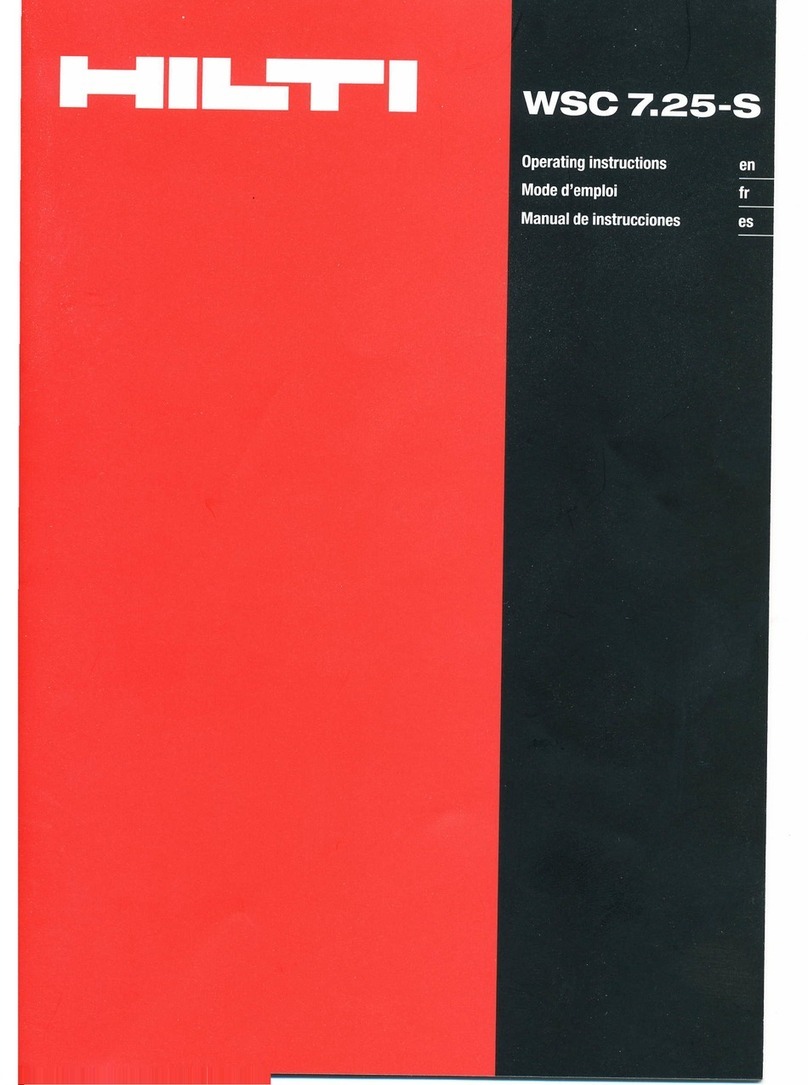
Hilti
Hilti WSG 7.25-5 User manual

Hilti
Hilti Nuron DSH 600-22 User manual
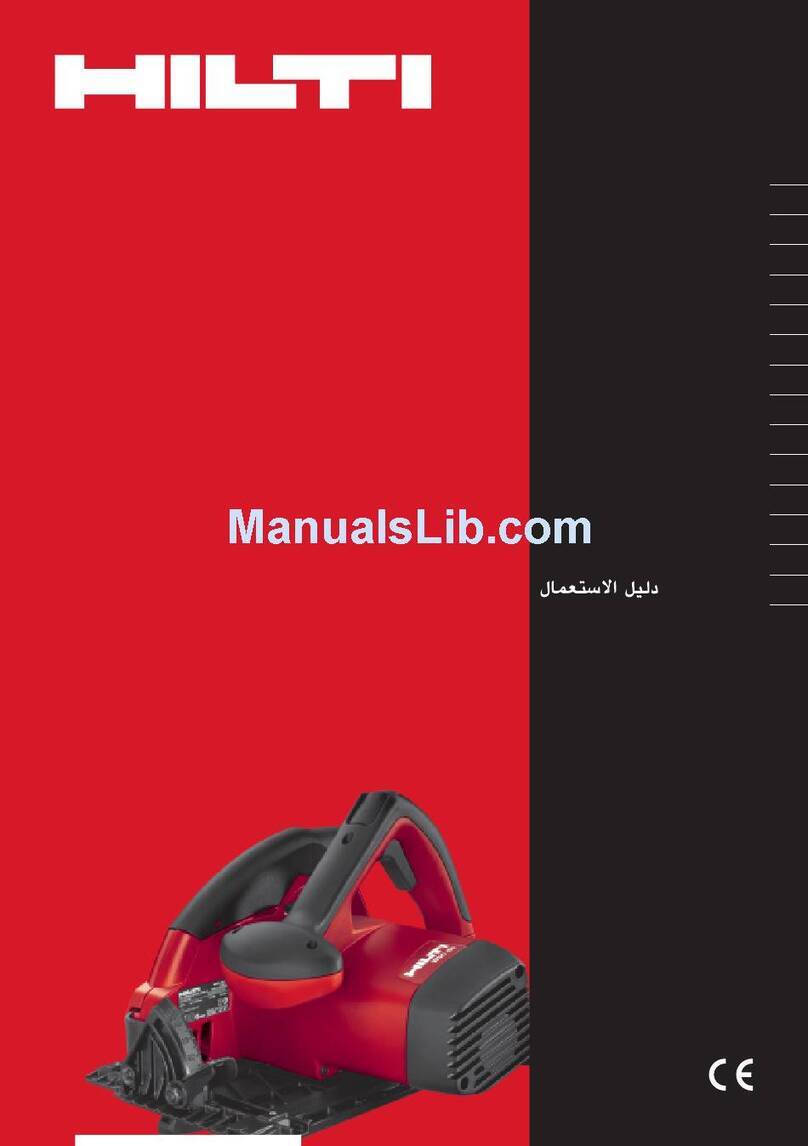
Hilti
Hilti WSC 70 User manual

Hilti
Hilti SCM 22-A User manual
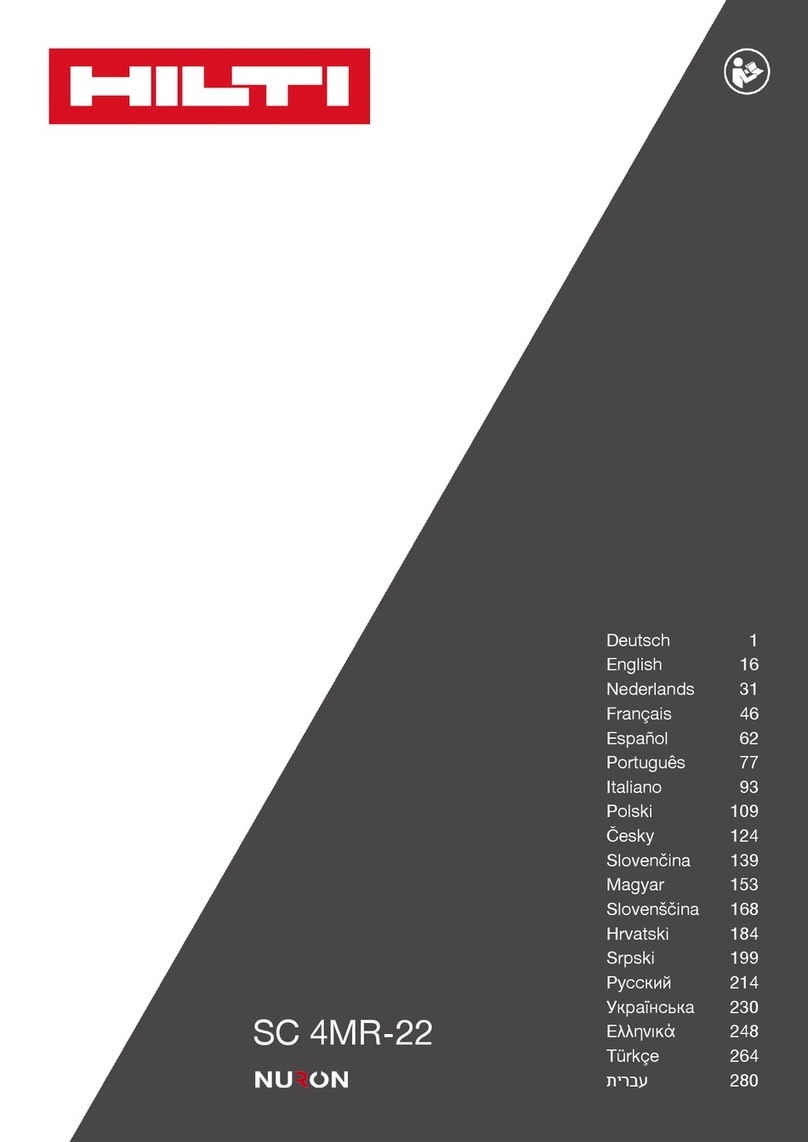
Hilti
Hilti Nuron SC 4MR-22 User manual

Hilti
Hilti SB 4-A22 User manual
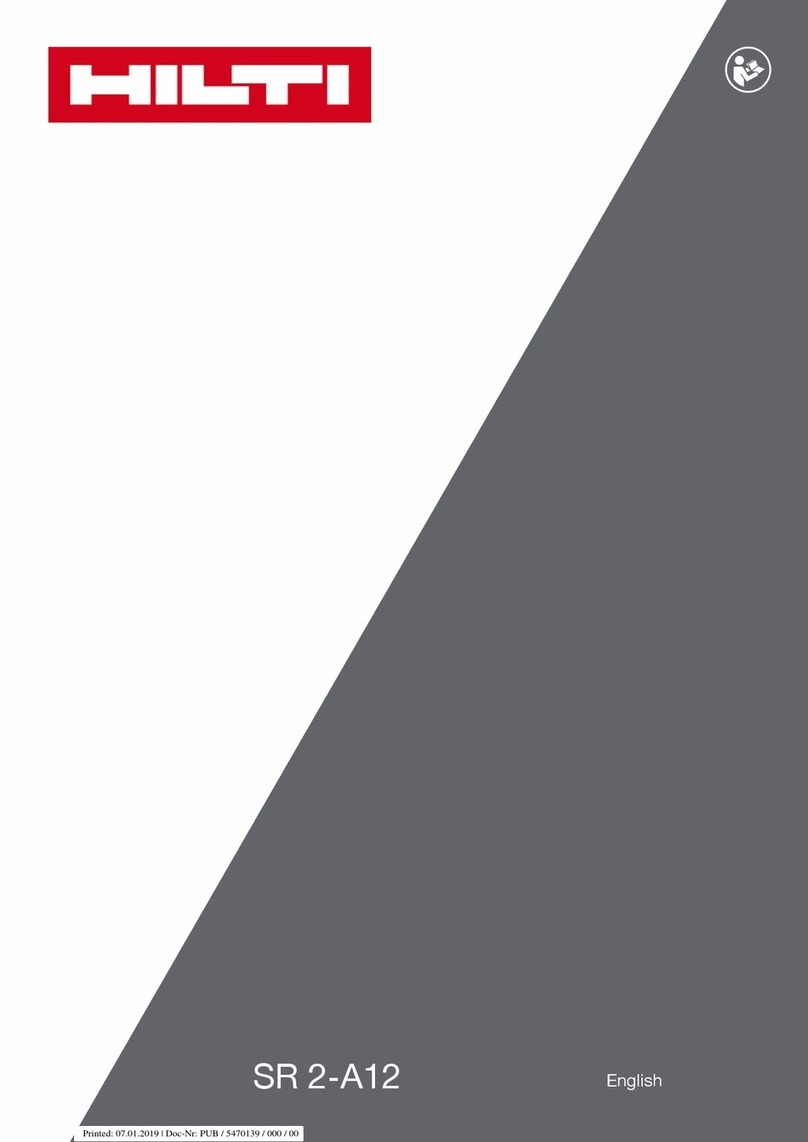
Hilti
Hilti SR 2-A12 User manual

Hilti
Hilti DSW 1005E User manual
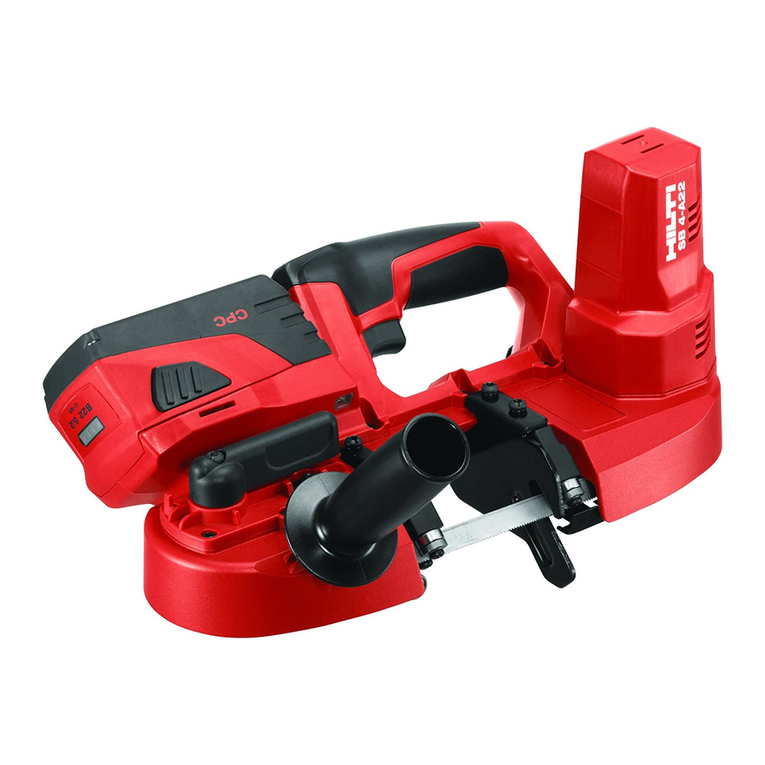
Hilti
Hilti SB 4-A22 User manual

Hilti
Hilti SC 70W-A22 User manual
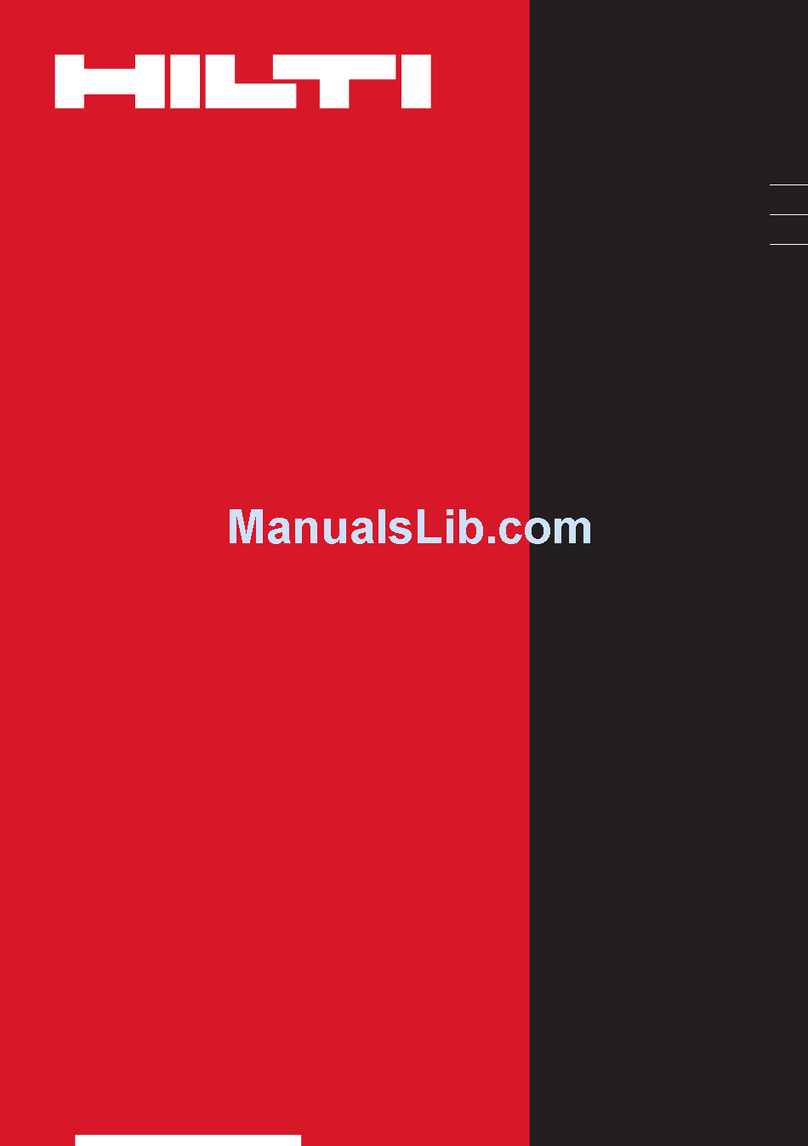
Hilti
Hilti SCW 18-A User manual



